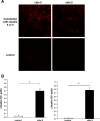Effect of claudins 6 and 9 on paracellular permeability in MDCK II cells
- PMID: 18784328
- PMCID: PMC2584851
- DOI: 10.1152/ajpregu.90596.2008
Effect of claudins 6 and 9 on paracellular permeability in MDCK II cells
Abstract
The neonatal proximal tubule has a lower permeability to chloride, higher resistance, and higher relative sodium-to-chloride permeability (P(Na)/P(Cl)) than the adult tubule, which may be due to maturational changes in the tight junction. Claudins are tight-junction proteins between epithelial cells that determine paracellular permeability characteristics of epithelia. We have previously described the presence of two claudin isoforms, claudins 6 and 9, in the neonatal proximal tubule and subsequent reduction of these claudins during postnatal maturation. The question is whether changes in claudin expression are related to changes in functional characteristics in the neonatal tubule. We transfected claudins 6 and 9 into Madin-Darby canine kidney II (MDCK II) cells and performed electrophysiological studies to determine the resultant changes in physiological characteristics of the cells. Expression of claudins 6 and 9 resulted in an increased transepithelial resistance, decreased chloride permeability, and decreased P(Na)/P(Cl) and P(HCO3)/P(Cl). These findings constitute the first characterization of the permeability characteristics of claudins 6 and 9 in a cell model and may explain why the neonatal proximal tubule has lower permeability to chloride and higher resistance than the adult proximal tubule.
Figures







References
-
- Alexandre MD, Lu Q, Chen YH. Overexpression of claudin-7 decreases the paracellular Cl− conductance and increases the paracellular Na+ conductance in LLC-PK1 cells. J Cell Sci 118: 2683–2693, 2005. - PubMed
-
- Angelow S, Schneeberger EE, Yu ASL. Claudin-8 expression in renal epithelial cells augments the paracellular barrier by replacing endogenous claudin-2. J Membr Biol 215: 147–159, 2007. - PubMed
-
- Angelow S, Yu ASL. Claudins and paracellular transport: an update. Curr Opin Nephrol Hypertens 16: 459–464, 2007. - PubMed
-
- Aronson PS, Giebisch G. Mechanisms of chloride transport in the proximal tubule. Am J Physiol Renal Physiol 273: F179–F192, 1997. - PubMed
Publication types
MeSH terms
Substances
Grants and funding
LinkOut - more resources
Full Text Sources

